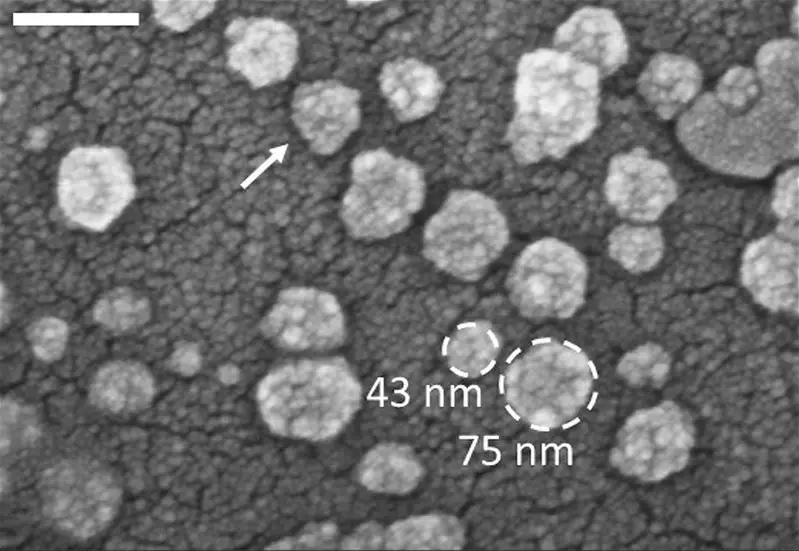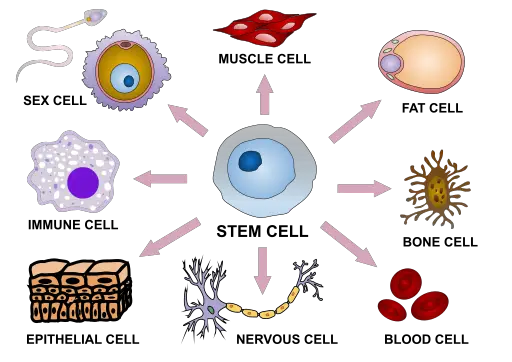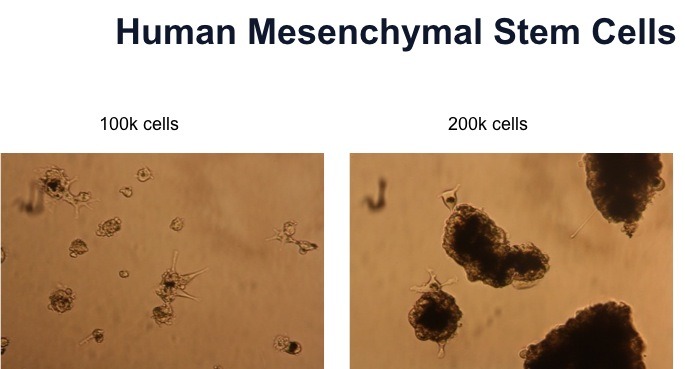Exosomes and Stem Cells
Overview: What are Exosomes?
Exosomes are small (nano-sized, between 30 and 150 nm in diameter) extracellular vesicles released by most cell types in the body. They carry a number of materials including proteins, nucleic acids, proteins, metabolites, etc.
Once they are released, exosomes transport their cargo to specific neighboring or distant cells. As such, they play an important role in the cellular communication system by influencing given responses depending on the material they transport to the recipient cells.
As they are released by nearly all cells in the body, exosomes can be found in various body fluids including the blood, cerebrospinal fluid, milk, tears, plasma, etc.
Like other eukaryotic cells, stem cells also release exosomes both under normal circumstances and pathological conditions. Mesenchymal stem cells, for instance, contain proteins, mRNAs, and miRNAs that can alter the function and fate of the recipient cells.
* Because of their ability to transport a variety of material to target cells, exosomes have been the subject of many medical therapies (exosomal therapy).
* Other examples of extracellular vesicles are shedding particles and apoptotic bodies (they are generally larger than exosomes).
And what are Stem cells?
A stem cell may be described as a cell capable of giving rise to a copy of itself as well as a differentiated (specialized) cell type. While some stem cells can differentiate to give rise to all cell types (totipotent), others are more limited and can only give rise to certain cell types.
These cells are divided into several categories that include:
- Pluripotent - E.g. Embryonic stem cells: Unlike totipotent cells which can give rise to the placenta and embryo, pluripotent can only differentiate to produce most cell types. However, this type of cell is incapable of producing a complete organism.
- Multipotent - Multipotent stem cells are the stem cells that are located in the specialized tissue of the fetus and adults. Though they can give rise to many cell types, they cannot produce all the cell types.
- Unipotent - Unipotent stem cells are more limited than the other stem cells because they can only give rise to one cell type.
Because of their ability to differentiate and give rise to different cell types in the body, stem cells have become particularly important in medicine because they can be used to repair and regenerate damaged tissue. Currently, some of the most popular stem cell therapies involve bone marrow transplantation and repair of damaged tissue.
* A fertilized egg and early blastomeres are considered totipotent cells.
Exosome Biogenesis and Release
(Production of Exosomes by Stem Cells)
As is the case with many other cells, exosomes in stem cells are formed from the endosomes through a process known as exocytosis.
It's worth noting that the process may be triggered by external factors. In this case, the plasma membrane of the cell first invaginates to take in the stimulating factor into the cell. This inward budding of the membrane forms the early endosome that buds off (breaks off) from the membrane.
Given that the endosome forms from the inward invagination of the membrane, it also consists of the phospholipid bilayer. The endosome also contains some cytoplasmic content.
With the cytoplasmic contents, the endosome then becomes a late endosome which consists of intraluminal vesicles (ILVs) known as multivesicular bodies. The endosome can then move its content into the lysosome for degradation or fuse with the membrane to release contents out of the cell.
On the other hand, specific signals can influence the sorting and packaging of appropriate material into the endosomes so that they can be released into the environment and move to target cells in the body as exosomes. Here, the endosomal sorting (following the formation of early endosomes) results in the formation of intraluminal vesicles and multivesicular bodies.
The intraluminal vesicles then move to the cell surface from where it's released into the extracellular matrix. Here, the exosomes may contain mRNAs or proteins that serve as signals to the target cells.
* The biogenesis of exosomes and their secretion is dependent on the endosomal sorting complex.
Within the cell, MVBs move by means of microtubule cytoskeleton as well as the directional transport of the cell membrane.
Following sorting and packaging, exosomes are released into the extracellular environment (secretion).
Contents of the exosomes are then transferred to the target cell through either of the following mechanisms:
- Endocytosis - This is one of the most common mechanisms through which contents are transferred to the recipient cell. In this case, the exosomes are internalized into the target cell with the help of clathrin, caveolin, or lipid rafts.
- Direct membrane fusion - In this case, the membrane of the exosomes fuses with the membrane of the target cell so that the contents of the exosomes can be released into the cell.
- Receptor-ligand interactions - This is a form of protein-protein interaction where the receptor of the target cell identifies and interacts with the ligand of the exosomes allowing the signal to be sent to the recipient cell.
The different types of contents sent from stem cells to target cells have different effects. RNAs are some of the most common cargo transported through the exosomes.
The different types of RNAs transported to target cells through exosomes include:
- mRNAs - A messenger RNA (mRNA) is a single-stranded molecule of RNA and is essentially complementary to one of the DNA strands (part of the strand/gene). In both normal/physiological and pathological conditions, these RNAs influence the production of given proteins in the recipient cell. Moreover, they have been associated with a number of additional functions including cellular development and RNA post-transcriptional modification, cell proliferation, cell migration, etc.
- miRNAs - MicroRNAs (miRNAs) are primarily involved in gene expression. Within the target cell, they are transcribed by the enzyme RNA polymerase resulting in primary transcripts that have to be processed further.
Once they are secreted and released via exosomes, these RNAs have the following effects:
- Regulate pluripotent factors - miRNAs regulate stem cells pluripotency by the pluripotency factors. For instance, they may achieve this by acting on the 3′ UTRs of the factors. In human beings, the microRNA 145 has been shown to prepress pluripotency of human embryonic stem cells by inhibiting the expression of the factors Oct4, Sox2, and Klf4.
- Stem cell differentiation - The stem cells have specific microRNA expression profiles that modulate the fate of the stem cells. This knowledge has been used to distinguish between stem cells and cells and thus treat a number of diseases (e.g. muscle and neurodegenerative diseases)
- Cardiovascular differentiation - MicroRNAs are also involved in the differentiation of cardiomyocyte progenitors and stem cells to give rise to cardiovascular cells. For instance, by targeting Sox6, microRNA 499 has been shown to influence the differentiation of human-derived cardiomyocyte progenitors in the cardiovascular system.
- Neural differentiation - MicroRNAs have also been shown to play an important role in neurogenesis. In the central nervous system, for instance, miR-124 is involved in neural differentiation of the subventricular zone in the adult brain. This is an important part of the brain that contains a variety of astrocyte-like cells and neuroblasts.
- Osteogenic and chondrogenic differentiation of stem cells - In studies involving adult stem cells, microRNAs have been shown to play an important role in modulating osteogenic and chondrogenic differentiation of stem cells. They achieve this by targeting various transcriptional factors and pathways of skeletal development. For instance, they are involved in the extracellular regulated kinase-dependent pathway (ERK) which is concerned with osteoblast differentiation. As well, miR-138 can inhibit the differentiation of human mesenchymal stem cells into osteoblasts by acting on (focal adhesion kinase) FAK and downstream signalling. Here, both activities show how the actions of microRNAs (transported by exosomes) modulate the differentiation of stem cells into osteogenic and chondrogenic cells.
- Regulate Hematopoietic differentiation - In mammals, MicroRNAs are also involved in hematopoiesis. For instance, ectopic expression of sequence containing microRNAs enhances primary hematopoietic progenitors. In this case, then, microRNAs are involved in the hematopoietic different ion of stem cells. In mice, on the other hand, microRNA 181 contributes to the differentiation process that result in the production of B lymphocytes.
Some of the other types of RNAs transported by exosomes include:
- lncRNAs - lncRNAs are mRNA-like transcripts with more than 200 nucleotides. However, their capacity for protein-coding is limited. They are involved in a number of functions including the organization of chromatin, regulation of gene post-transcription, as well as gene transcription. They have been identified in exosomes found in various body fluids as well as tumor cells, etc.
- circRNAs - Circular RNAs are generally characterized by greater stability as compared to other types of RNAs found in eukaryotic cells. They consist of covalently closed loops without the 5' caps and 3' poly-tails. Compared to lncRNAs, circular RNAs serve a modulatory role in tumor microenvironments.
Advantages and Disadvantages of Mesenchymal Stem Cell Exosomes in Nanomedicine
Advantages
Mesenchymal stem cells are some of the well-studied stem cells. The exosomes released by these stem cells have several advantages over stem cells.
Mesenchymal stem cells can circumvent various issues associated with cell therapy - Generally, exosome-based therapies have been shown to evade various issues associated with cell therapies. These include problems like necrosis and abnormal differentiation resulting from stress reactions.
As mediators of stem cell paracrine action, exosomes circumvent these problems by transmitting information between the cells (stem cell to recipient cell). For this reason, the exosomes can be combined with newly developed methods to serve as carriers for a variety of particles to be transported to specific cells.
One of the biggest advantages of exosomes is the fact that they have autonomous targeting abilities. As such, they can be used to send specific signals to target cells effectively. This not only eliminates the necessity of interfering with stem cells (which can result in abnormal/unwanted differentiation) but also ensures that various particles (components) are effectively transported to the target cells using the autonomous targeting ability of exosomes.
Biocompatibility, Stability, Long-distance Communication, and Better Delivery Capabilities
Today, many studies and research have allowed for the development of synthetic nanoscale carriers like liposomes and nanoparticles. While these carriers have a number of benefits, exosomes are naturally biocompatible, they can travel longer distances to deliver communication signals, and naturally fuse with the target cells, etc.
For instance, as natural microvesicles, they are better at penetrating the blood-brain barrier than nanoparticles. For this reason, the combination of exosomes and synthetic nanoparticles is expected to yield better results in the future of nanomedicine.
Possible Applications of Stem Cell Exosomes
Due to the advantages associated with exosomes, they are expected to play an important role in the following areas of medicine:
- Tumor therapy - Though there are a number of existing methods for treating and managing malignant tumors (e.g. radiotherapy and chemotherapy, etc.), they are not sufficiently effective to meet clinical needs. In recent years, however, there has been a lot of attention towards tumor biotherapy as a potentially better strategy. This will involve combining the strengths of stem cell-derived exosomes and advancements in nanotechnology to target and destroy tumorous cells. For instance, using extracellular vesicles derived from the mesenchymal cells of the human umbilical cord, it might be possible to target and destroy lung cancer cells while also inhibiting their proliferation.
- Immunoregulation - According to a number of studies, exosomes derived from mesenchymal stem cells can be used to effectively regulate innate and adaptive immune cells. This is especially expected to be highly beneficial in treating autoimmune diseases. By using exosomes, these cells can be targeted and controlled in order to manage or treat the disease.
- Wound healing and tissue regeneration - Naturally, mesenchymal stem cells are involved in several activities including tissue regeneration and tissue repair. Based on this knowledge, researchers seek to use exosomes derived from these stem cells to improve these processes (including anti-aging applications). In recent studies, findings have revealed that microvesicles (exosomes) derived from mesenchymal stem cells can be used to target and influence cell proliferation in affected sites and thus enhance wound healing processes and tissue regeneration. Exosomes can effectively serve this function because they can naturally target and move to specific cells with a variety of components aimed at influencing desired outcomes.
Return from Exosomes and Stem Cells to MicroscopeMaster home
References
Binglin Yue et al. (2020). Exosome biogenesis, secretion and function of exosomal miRNAs in skeletal muscle myogenesis.
Christine Mummery. (2014). Stem Cells: Scientific Facts and Fiction.
Na Li, Bo Long, Wei Han, Shumin Yuan and Kun Wang. (2017). microRNAs: important regulators of stem cells.
Wumei Wei et al. (2021). Mesenchymal Stem Cell–Derived Exosomes: A Promising Biological Tool in Nanomedicine.
Links
https://translational-medicine.biomedcentral.com/articles/10.1186/s12967-020-02622-3
https://stemcellres.biomedcentral.com/articles/10.1186/s13287-021-02138-7
Find out how to advertise on MicroscopeMaster!







